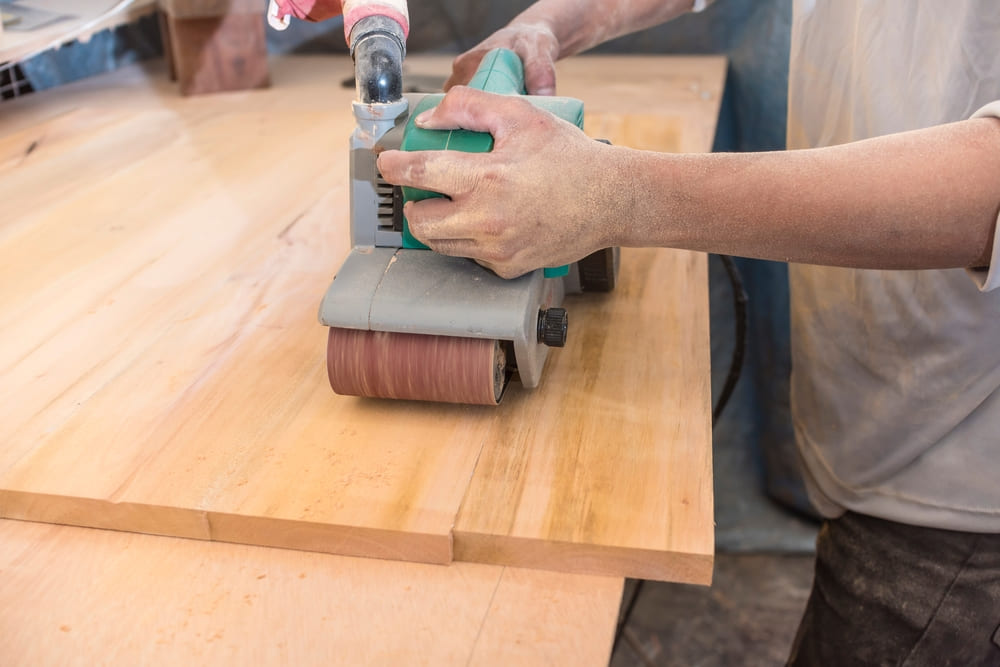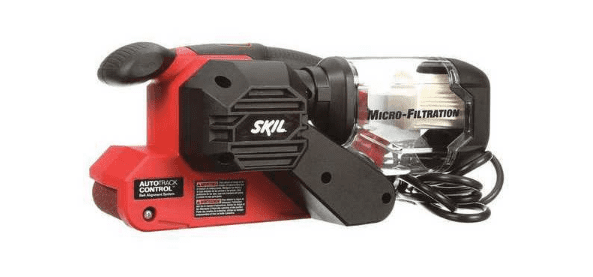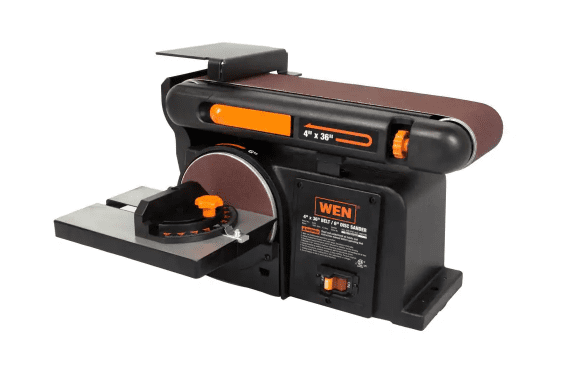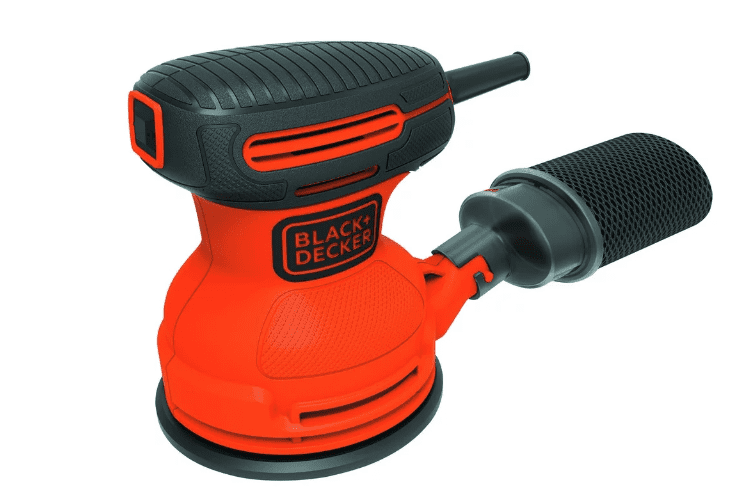YOUR NO 1 WOODWORKING POWER TOOLS RESOURCE WEBSITE
Belt Sander vs Orbital Sander: Choosing The Best For Your Sanding Needs

Disclosure: If you click on some of the links, we may earn a small referral fee. Please know that we only recommend products that we use and believe will add value to our readers.
Looking to achieve smooth and polished surfaces? If so, you’ve likely come across two popular options: belt sanders and orbital sanders. Making the right selection between these two sanders can greatly impact the quality and efficiency of your work.
In this article, we will delve into the key differences between the belt sander and the orbital sander, providing you with the knowledge you need to make an informed decision. Whether you’re tackling a large-scale woodworking project or simply refinishing a piece of furniture, understanding the strengths, weaknesses, and specific use cases of each type of sander is essential.
See our list of must-have power tools for a typical woodworking shop
Belt Sander vs Orbital Sander (Summary Table)
|
PARAMETER |
BELT | ORBITAL | |
|
Speed |
Higher speed | Lower speed | |
|
Power |
Highly powerful | Less powerful | |
|
Project Size |
Large-scale projects and rough surfaces | Small or rounded jobs | |
|
Material |
Hardwoods and rough stock | Wood and metal surfaces | |
|
Sanding Method |
Continuous loop sanding | Circular or orbital motion | |
|
Sanding Grit |
Coarse grits | Finer grits | |
|
Use cases |
Leveling surfaces, rough sanding | Smoothing edges, detail work | |
|
Dust collection |
Varies by model | Efficient dust collection | |
|
Ease of use |
Requires skill and caution | Easier to handle | |
|
Cost |
Cost varies | More affordable |
Belt Sander – An Overview

Belt sanders are powerful tools that are designed for fast material removal and leveling of surfaces. They operate by using an electric motor to rotate a pair of drums, which in turn move a continuous loop of sandpaper known as the sanding belt. The sanding belt, typically 3 inches wide, aggressively removes material as it rotates, making belt sanders best suited for rough sanding tasks.
The speed of a belt sander is measured in feet per minute (FPM) and determines how quickly the sanding belt oscillates. Higher FPM means faster sanding. Some models come with variable speed options, allowing you to adjust the speed for different applications or to achieve more precise results.
The power of a belt sander is measured in amps. Most belt sanders have power ratings between 8 and 11 amps. Choosing a belt sander with higher amperage provides more power and torque, allowing for faster material removal and efficient sanding.
The Two Main Types of Belt Sanders
Stationary Belt Sander
Also known as a bench sander, a stationary belt sander is mounted on a workbench or comes with its own stand. When using a stationary belt sander, you bring the material to the sander, holding it against the sanding belt. This type of sander is ideal for working with smaller pieces of wood and can also be used as a tool sharpener for both wood and metal.
Handheld Belt Sander
A handheld belt sander is portable and comes with a handle and trigger for ease of use. With a handheld belt sander, you move the sander itself across the surface of the material. This type of sander offers more flexibility and control, making it suitable for larger stock and working on flat surfaces.
Strengths of The Belt Sander: When to Use It
Belt sanders are valuable in the following situations:
Sanding Large Surfaces
Belt sanders are highly efficient when it comes to sanding large surface areas. Whether you’re working on a hardwood floor, a tabletop, or a wooden deck, a belt sander can quickly remove material and level the surface.
Aggressive Material Removal
Belt sanders are known for their aggressive sanding capability. They excel at removing significant amounts of material and smoothing rough surfaces. If you need to tackle heavy-duty sanding tasks that require quick material removal, a belt sander is the ideal choice.
Working with Metal
Belt sanders are not limited to woodwork alone. They can also be used for metalworking projects. With the right sanding belt, a belt sander can effectively remove rust, paint, and imperfections from metal surfaces.
Weaknesses of The Belt Sander: When Not To Use It
Belt sanders have some limitations too:
Not Suitable for Small Surfaces
Due to their aggressive nature, belt sanders are not recommended for sanding small or delicate surfaces. They can easily remove too much material and leave behind noticeable sanding marks. It’s best to use a different type of sander, such as an orbital sander, for more precise and controlled sanding on smaller pieces.
Noise and Vibrations
Belt sanders operate at high speeds, resulting in loud noise and vibrations. It is advised to wear ear protection and use the tool in short bursts to minimize the strain on your body.
Our Recommended Belt Sanders
1. Skil 7510-01 3″ x 18″ Belt Sander

The Skil 7510-01 is a solid option for those seeking a reliable and affordable belt sander. It boasts a 6-amp motor that delivers ample power for various sanding tasks. The 3-inch by 18-inch sanding belt provides a wide coverage area, allowing for efficient material removal. One standout feature of this sander is the auto-tracking belt system, which ensures that the sanding belt stays aligned and doesn’t slip during operation. Additionally, the pressure control indicator helps maintain the right amount of pressure for optimal results. The Skil 7510-01 also features a micro-filtration dust canister, effectively capturing dust and keeping your work area cleaner.
Get the Skil 7510-01 3″ x 18″ Belt Sander Available at:
2. WEN 6502T 4.3A 4 x 36 in. Belt and 6 in. Disc Sander

The WEN 6502T is a versatile belt sander that combines the functionality of a belt sander and a disc sander into one unit. This allows for greater flexibility and the ability to perform different sanding tasks using a single tool. With a 4.3-amp motor, the sander delivers ample power for efficient material removal. The 4 x 36-inch belt and 6-inch disc offer a versatile sanding surface for various project sizes and materials. The WEN 6502T sander also features a cast iron base, providing stability during operation and contributing to its overall durability. Furthermore, it includes a dust port that can be connected to a dust extraction system, helping to keep your workspace clean and free from debris.
Get the WEN 6502T 4.3A Belt and Disc Sander Available at:
Orbital Sander – An Overview

An orbital sander is a versatile tool that operates by using a sandpaper disc that moves in small circles or orbits, hence the name “orbital.” This circular sanding motion allows for efficient sanding and makes it easier to cover larger surface areas in less time. The orbital sander is designed with a square-shaped body that enables it to access corners and tight spaces.
The speed of an orbital sander is measured in orbits per minute (OPM), indicating how many times the sanding disc rotates in one minute. Most orbital sanders have a speed of around 10,000 orbits per minute. Higher speeds allow for faster sanding, especially on large surfaces. Some models come with variable speed options, which can be beneficial when working on intricate areas that require more control and finesse.
The power of an orbital sander is measured in amps, similar to a belt sander. However, orbital sanders are not intended for heavy-duty tasks that require significant material removal. They are more suitable for providing a smooth finish after using a belt sander or for lighter sanding projects. The power range of orbital sanders is typically lower compared to belt sanders.
Orbital Sander: Handle Types
Palm Grip Handles
These handles are designed to fit comfortably in the palm of your hand. They offer a compact size and ease of use, making them a popular choice for orbital sanders. They provide good control and stability for precise sanding.
Jug-Grip Handles
Also known as D-handles, these handles allow you to grip the sander at the rear rather than on top. This design is beneficial when working on surfaces with limited space above the sander, as it provides better maneuverability while maintaining control.
Pistol-Grip Handles
Pistol-grip handles are suitable for those experienced in using orbital sanders. They allow for single-handed operation, providing convenience and flexibility. However, they may require more skill to maintain control, especially for intricate or delicate sanding tasks.
Strengths of The Orbital Sander: When To Use It
The orbital sander has several strengths that make it a valuable tool in specific situations:
Smoothing and Finishing
The orbital sander is ideal for achieving a smooth and fine finish on wood surfaces. It operates by sanding in small circular or orbital motions, which helps to eliminate visible sanding marks and create a more uniform surface.
Working on Small and Contoured Surfaces
Due to its compact size and ability to maneuver into tight spaces, the orbital sander is well-suited for sanding small areas, corners, and intricate details. Its gentle sanding action makes it suitable for delicate work and areas that require precision.
Minimizing Material Removal
The orbital sander is designed to remove minimal amounts of material at a time, making it ideal for fine-tuning and refining surfaces rather than heavy material removal. It is commonly used for final sanding, preparing wood for painting or staining, or achieving a polished surface.
Weaknesses of The Orbital Sander: When Not To Use It
While the orbital sander has its strengths, it is important to consider its limitations:
Material Removal Speed
As mentioned earlier, the orbital sander is not as efficient as a belt sander when it comes to material removal. If you have a large amount of material to be removed or rough surfaces that need significant leveling, a belt sander would be a more appropriate choice.
Slower Sanding Process
Due to its gentle and precise sanding action, the orbital sander may take longer to complete sanding tasks compared to a belt sander. If time efficiency is essential for your project, the orbital sander may not be the most efficient option.
Not Suitable for Heavy-Duty Sanding
If you are dealing with extremely rough surfaces, deep scratches, or heavy-duty sanding tasks, an orbital sander may not provide enough power or aggression to tackle these demanding jobs effectively.
Our Recommended Orbital Sanders
Here are two top options you should consider:
1. BLACK+DECKER Orbital Sander, 5 Inch, 2.0 Amp (BDERO100)

This orbital sander combines power and versatility, making it a great choice for various sanding tasks. With a 2.0 amp motor, it delivers an impressive 12,000 orbits per minute (OPM). The lightweight and compact design of this sander allows for easy maneuverability and access to tight spaces. It includes a dust collection bag to minimize dust and debris during sanding, ensuring a cleaner work environment. The BLACK+DECKER Orbital Sander comes with a 5-inch sanding pad, providing ample coverage for efficient sanding.
Get the BLACK+DECKER (BDERO100) Orbital Sander Available at:
2. DEWALT 20V MAX (DWE6421K) 5in, 3A, Orbital Sander Kit

If you’re looking for a high-performance orbital sander, consider the DEWALT 20V MAX Orbital Sander Kit. With a powerful 3-amp motor and variable speed control, ranging from 8,000 to 12,000 OPM, this sander offers exceptional versatility and control. The rubberized over-molded grip provides comfort and reduces vibrations during use. Additionally, the DEWALT Orbital Sander features a dust-sealed switch and a dust collection system with a bag, ensuring efficient dust extraction and a cleaner work area.
Get the DEWALT 20V MAX Orbital Sander Kit available at:
Belt Sander or Orbital Sander (Side-by-Side Comparison)
Let’s compare these two sanders based on some parameters.
Speed
Belt sanders typically have higher speeds measured in feet per minute (FPM) compared to orbital sanders, which are measured in orbits per minute (OPM). The higher speed of belt sanders allows for faster material removal.
Power
Belt sanders are generally more powerful than orbital sanders due to their purpose of heavy-duty sanding and material removal. They have higher amperage ratings, providing the necessary torque to handle demanding tasks.
Project Size
Belt sanders are well-suited for larger projects or surfaces where significant material removal is required. On the other hand, orbital sanders are better for smaller projects or delicate tasks that require precision.
Material
Both sanders can handle various materials. Belt sanders are particularly effective on hardwoods and rough stock, whereas orbital sanders perform well on both wood and metal surfaces.
Sanding Method
Belt sanders use a continuous loop of sandpaper on rotating drums, ideal for aggressive material removal. Orbital sanders, with their circular or orbital motion, provide more delicate sanding and finer finishing.
Sanding Grit
Belt sanders are commonly used with coarser grits, while orbital sanders handle finer grits for smoother finishes.
Varieties
Belt sanders are generally available in stationary and handheld versions. Orbital sanders come in palm grip, jug-grip, and pistol-grip handle options, catering to different user preferences and comfort.
Use Cases
Belt sanders are suitable for heavy material removal, leveling surfaces, and sanding large areas. Orbital sanders are great for detail work, smoothing edges, refinishing furniture, and achieving a polished finish.
Ease of Use
Belt sanders require some skill and caution due to their power and aggressiveness. Orbital sanders are generally easier to handle, providing better control and precision.
Dust Collection
Both types of sanders often come equipped with dust collection systems or ports. However, orbital sanders tend to have more efficient dust collection due to their design, which can contribute to a cleaner working environment.
See our comprehensive guide to dust collection in a woodworking shop
Cost
The cost of belt sanders can vary depending on their power and features. Orbital sanders are generally more affordable, making them a budget-friendly option.
Frequently Asked Questions (FAQs)
Can an orbital sander be used for all sanding tasks?
No, an orbital sander is not suitable for all sanding tasks. It is best used for fine sanding, surface preparation, and finishing work. For heavy material removal or sanding larger surfaces, a belt sander would be more appropriate.
Which sander is more beginner-friendly?
While both sanders can be used by beginners, orbital sanders are generally considered more beginner-friendly. They are easier to control, provide smoother sanding results, and are less likely to cause damage or mistakes on the workpiece.
See our detailed review of the best sanders for wood projects
What about the Random Orbital Sander?
The random orbital sander combines the advantages of both belt sanders and orbital sanders. It is suitable for various sanding tasks, including removing material, achieving a smooth finish, and fine detail work. It provides a random sanding pattern, minimizing the risk of visible scratch marks on the surface.
Which sander is best at removing paint?
When it comes to removing paint, a belt sander is generally more effective. Its aggressive sanding action and powerful motor allow it to strip multiple layers of paint efficiently. However, caution should be exercised to prevent damage to the underlying surface. Orbital sanders can also remove paint, but they are better suited for lighter paint removal tasks or for creating a smooth, finished surface after using a belt sander.
Final Verdict
If you are working on larger projects that require heavy material removal, leveling surfaces, or working with rough stock, a belt sander is the more suitable option. On the other hand, if you need to achieve a smooth finish, perform detail work, or work on smaller projects that require precision, an orbital sander is the better choice.
Did you know? you can convert an angle grinder into a sander with the right accessories. Here are 11 angle grinder attachments for wood projects.
Enjoy our articles? You can follow us on Pinterest for more woodworking power tools tips and tricks.
Save on selected power tools from top brands - Shop Now on Zoro.



